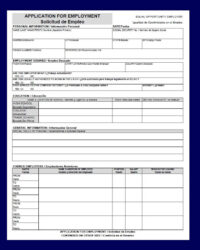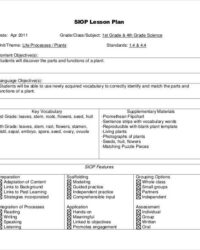In today’s diverse classrooms, educators are constantly seeking innovative ways to support students from various linguistic backgrounds. Dual language programs have emerged as a powerful solution, fostering bilingualism and biliteracy while ensuring academic success across subjects. But how do you effectively weave two languages into every lesson? The secret often lies in meticulous planning, and that’s where a well-structured dual language lesson plan template becomes indispensable. It’s more than just a form; it’s a strategic tool designed to harmonize instruction in two distinct languages.
Imagine the complexities of ensuring every student, whether learning in English or another target language like Spanish or Mandarin, receives equitable and comprehensive instruction. This isn’t about teaching two separate lessons; it’s about integrated learning that leverages both languages as resources for understanding and expression. A robust template provides a clear roadmap, guiding teachers through the essential elements of planning for a classroom where linguistic diversity is not just accommodated but celebrated and leveraged for deeper learning.
Designing an Effective Dual Language Lesson Plan Template
Creating a truly effective dual language lesson plan template goes beyond simply adding a column for “Spanish” or “English.” It requires a deep understanding of pedagogical approaches unique to bilingual education, such as content and language integrated learning (CLIL), translanguaging, and scaffolding. A well-designed template encourages teachers to think critically about how language objectives are integrated with content objectives, ensuring that students are not only grasping new concepts but also developing proficiency in both target languages simultaneously. It should prompt reflection on how to make learning accessible to all learners, regardless of their current language dominance, by providing opportunities for interaction, clarification, and practice in both linguistic contexts.
One of the core challenges in dual language instruction is maintaining a balance between the two languages. A comprehensive template helps address this by prompting specific sections for language allocation – indicating which language will be primarily used for direct instruction, group work, or assessments. This structured approach helps prevent one language from inadvertently dominating classroom time, ensuring that students receive consistent exposure and practice in both. Moreover, it encourages teachers to pre-plan for language support strategies, like providing cognates, visual aids, or sentence frames, which are crucial for bridging linguistic gaps and fostering comprehension across the curriculum.
Key Components to Include
To ensure your dual language lesson plan template is as comprehensive as possible, consider incorporating dedicated sections for the following:
- Content Objectives: Clearly defined academic goals for the lesson.
- Language Objectives: Specific language skills students will practice or acquire (e.g., “Students will be able to describe” in English and Spanish).
- Language of Instruction: Specifies which language will be used for each part of the lesson.
- Vocabulary: Key terms in both languages, with strategies for teaching them.
- Materials: List of resources, noting if they are bilingual or specific to one language.
- Formative Assessment: How will understanding be checked in both languages?
- Differentiation: Strategies for supporting varying language proficiency levels.
Incorporating Culturally Responsive Pedagogy
Beyond language mechanics, an exemplary dual language lesson plan template encourages the integration of culturally responsive teaching practices. This means thinking about how the content connects to students’ backgrounds, experiences, and prior knowledge from their home cultures. Including prompts or sections for cultural connections helps teachers select materials and activities that resonate with their diverse learners, making the learning experience more meaningful and engaging. It reinforces the idea that language learning is not just about vocabulary and grammar, but also about understanding and appreciating different worldviews, which is a cornerstone of true bilingual and bicultural proficiency.
Maximizing the Impact of Your Template
Simply having a dual language lesson plan template is the first step; the real magic happens when educators consistently utilize it as a dynamic planning tool. It’s not about rigid adherence, but rather about leveraging its structure to inspire thoughtful lesson design. Regular use encourages a proactive approach to teaching, where potential linguistic barriers are identified and addressed before they even arise in the classroom. This systematic planning fosters a more equitable learning environment, ensuring that all students, regardless of their linguistic background, have the scaffolding and support necessary to thrive academically and linguistically.
To get the most out of your template, consider it a living document that evolves with your teaching experience and student needs. After each lesson, reflect on what worked well regarding language integration and what could be improved. Did students struggle with a particular concept due to language? Was there enough opportunity for them to produce language in both English and the target language? These reflections can inform how you fill out the template for future lessons, refining your approach and making your instruction even more effective. Collaboration with co-teachers or other dual language educators can also provide invaluable insights and different perspectives on optimizing the template’s use.
Here are some practical tips for maximizing the utility of your dual language lesson plan template:
- Start Simple: Don’t try to fill every single box perfectly at first. Focus on the core elements like content objectives, language objectives, and language of instruction.
- Review and Revise: Treat the template as a draft. Review it before teaching and make adjustments based on student needs or unexpected challenges.
- Share and Collaborate: Work with colleagues. Sharing templates and planning ideas can lead to stronger, more innovative lessons.
- Utilize Digital Tools: Consider digital versions of your template for easier editing, sharing, and storage, potentially incorporating multimedia links directly into your plan.
- Student Input: Where appropriate, involve students in setting language goals or selecting culturally relevant materials to boost engagement.
The journey of teaching in a dual language environment is incredibly rewarding, offering students the gift of bilingualism and a deeper understanding of the world. Effective planning is the cornerstone of this success, transforming complex linguistic landscapes into opportunities for rich, integrated learning. By embracing a well-designed lesson planning framework, educators can confidently navigate the nuances of teaching in two languages, ensuring that every lesson is purposeful, equitable, and highly engaging for all learners. It empowers teachers to be linguistic architects, building bridges between languages and cultures within the classroom walls.
Ultimately, the impact extends far beyond academic achievement. Students who learn in dual language settings develop cognitive flexibility, enhanced problem-solving skills, and a global perspective that prepares them for an interconnected world. The structured approach offered by a thoughtful lesson template is not just about organizing teaching; it’s about cultivating these profound lifelong benefits for a new generation of bilingual and biliterate citizens. It streamlines the planning process, allowing teachers to focus more on the art of instruction and less on the mechanics of organization, leading to more vibrant and successful dual language programs.


